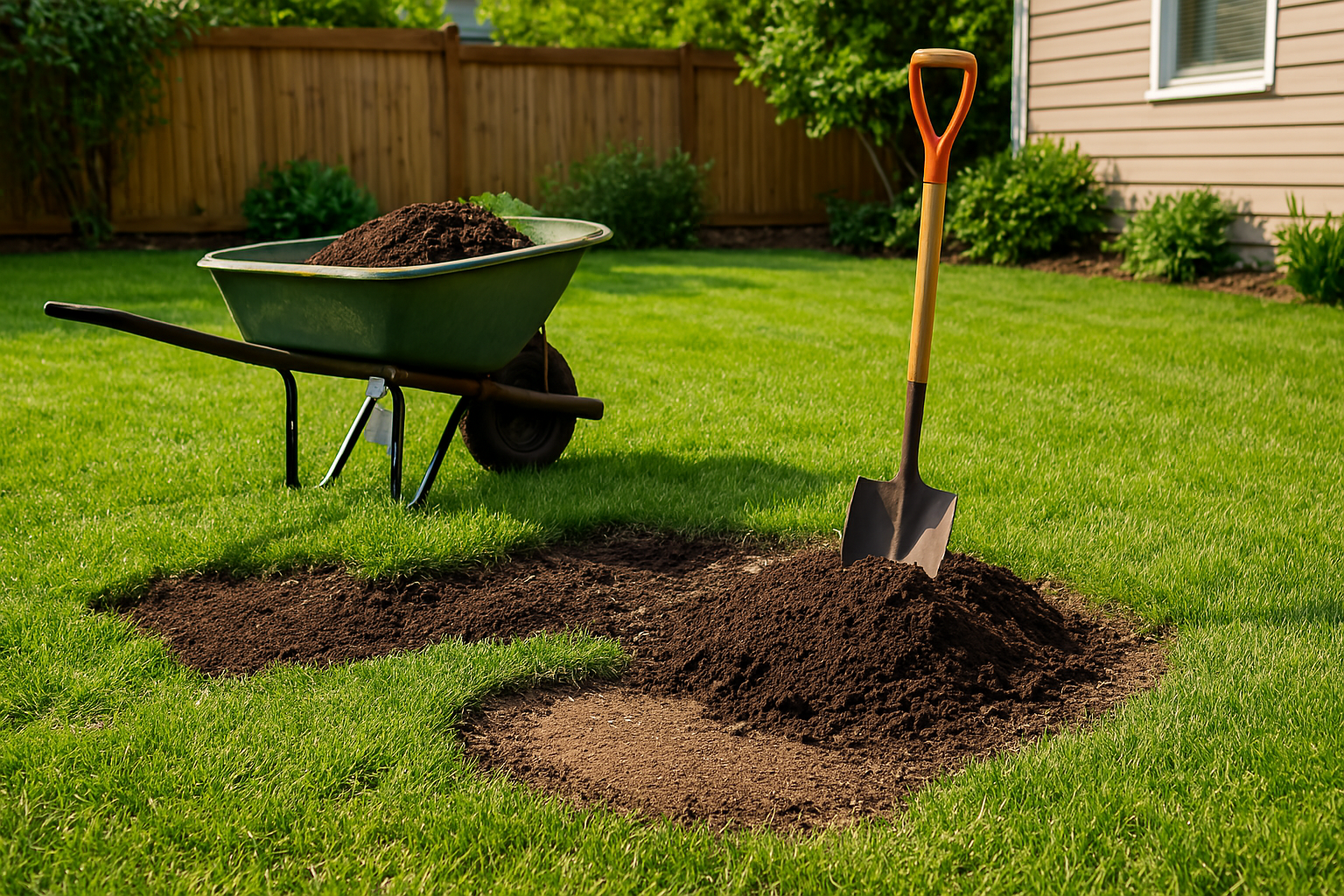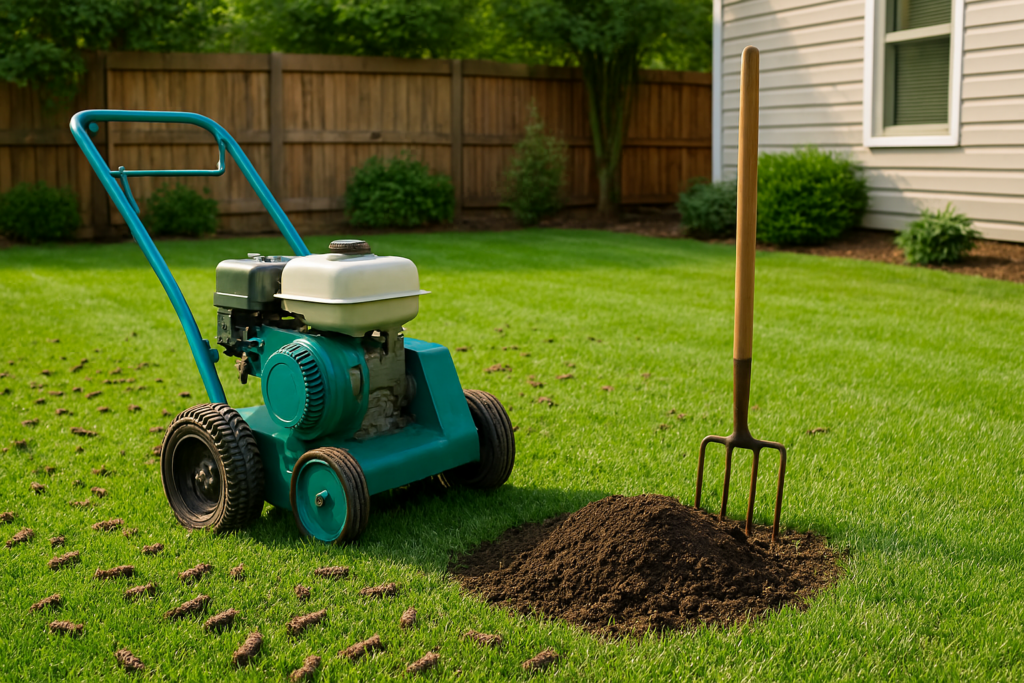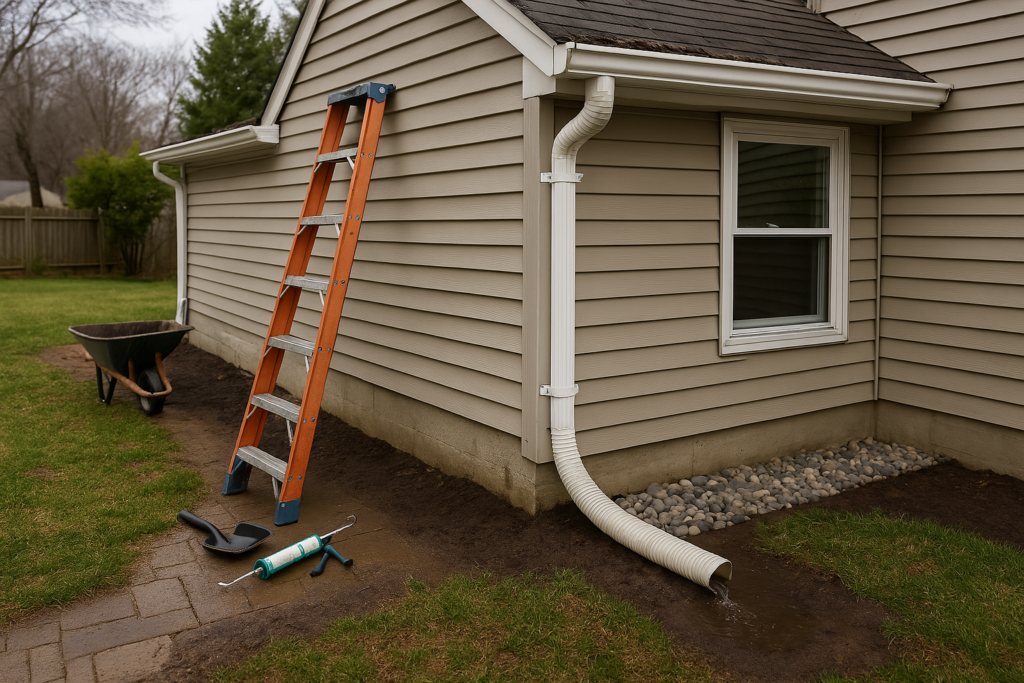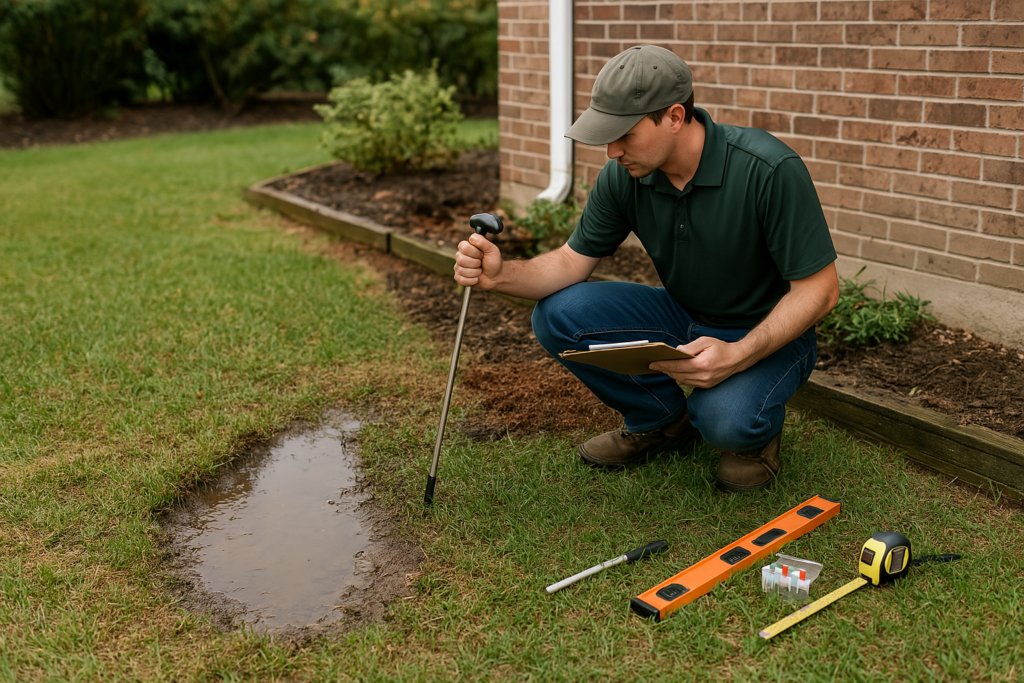How to Improve Drainage in Your Yard (2025 Guide)
aquaserene
April 10, 2025
1. Common Drainage Fixes That Work
1.1 Build Up Low Spots in the Lawn
1.2 Aerate the Lawn to Combat Compacted Soil
1.3 Install a French Drain
1.4 Build a Rain Garden
2. Natural Solutions – Swales & Creek Beds
2.1 Create a Swale (Natural Drainage Ditch)
2.2 Add a Dry Creek Bed (Stylish & Functional)
3. Gutter Fixes, Risks, and When to Hire a Pro
3.1 Clean Gutters and Redirect Downspouts
3.2 When to Call a Drainage Professional
3.3 What to Expect from a Professional Drainage Contractor
4. Why Is Improving Drainage So Important?
5. FAQs, Plants, and Local Tips
5.1 Frequently Asked Questions (FAQ)
5.2 Plants That Soak Up Water in Wet Yards
5.3 Quick Fixes for Small Drainage Problems
5.4 Cincinnati-Specific Drainage Tips
6. Final Thoughts: Yard Drainage Is the Key to a Healthy Landscape
Common Drainage Fixes That Work

Reading time: 5-6 Minutes
Tired of soggy spots or standing water after every rain? This section covers practical, homeowner-friendly drainage solutions that target the most common yard issues. From leveling low areas and aerating compacted soil to installing French drains and rain gardens, these tried-and-true fixes will help you redirect water, improve soil absorption, and restore a healthier landscape — without expensive overhauls.
Build up Low Spots in the Lawn
One of the most common culprits behind standing water is low or sunken areas in your yard. These depressions act like shallow bowls, trapping water instead of letting it drain naturally into the surrounding soil.
How to Fix Low Spots:
- Identify areas that consistently hold water — often near patios, fences, or downspouts.
- Mix topsoil with organic compost or aged manure.
- Fill the low spot with the mixture until it forms a slight rise (around 1–2 inches higher than surrounding soil).
- Compact it lightly, water it, and monitor over a few days.
- You may need to repeat this process multiple times if the ground settles again after rain.
- Once stable, overseed the area with grass seed, then cover with straw to protect it from birds and erosion.
Pro Tip: If low spots keep returning or appear in different areas of your yard, there may be a larger grading issue. In this case, consider having a landscaping expert assess the slope of your property.
Aerate the Lawn to Combat Compacted Soil

Compacted soil is another major cause of poor yard drainage especially in high traffic areas like walkways, kids’ play zones, or around patios. When soil is packed tight, water can’t seep through and gets stuck on the surface.
What Aeration Does:
Aeration is the process of perforating the lawn by pulling out small plugs of soil. These holes:
- Loosen the soil structure
- Improve oxygen and nutrient absorption
- Allow water to soak deeper instead of running off the surface
You can rent a core aerator or hire a lawn care pro to do the job. Aim to aerate your yard once a year ideally in the spring or fall, when the soil is moist but not soggy.
Bonus Tip: Garden beds can get compacted too! Use a rake or pitchfork to gently loosen mulch or compost layers so water doesn’t just run off.
Install a French Drain
When water is pooling in specific areas — like near your home’s foundation, along walkways, or beside driveways — a French drain is often the most effective solution. This underground system redirects excess water away from your home by allowing it to flow through a gravel-lined trench and into a perforated pipe.
What Is a French Drain?
A French drain is essentially a shallow trench (usually 12 to 24 inches deep) that’s:
- Lined with landscape fabric
- Filled with gravel or crushed stone
- Contains a perforated pipe that collects and redirects water
The entire setup is designed to leverage gravity — meaning the trench must slope away from the house or soggy area to guide water downhill and safely disperse it.
Should You DIY or Hire a Pro?
Installing a French drain is an advanced landscaping project. You’ll need to:
- Measure proper trench depth and slope
- Avoid utility lines
- Manage drainage destinations (like storm sewers, dry wells, or swales)
If that sounds overwhelming, hire a drainage specialist. They’ll ensure the drain performs correctly — protecting your home and landscape from long-term water damage.
Fun Fact: French drains aren’t just for homes. They’re commonly used on sports fields, golf courses, and farms to manage excess water efficiently.
Build a Rain Garden

A rain garden is a beautiful and eco-friendly way to manage stormwater while enhancing your landscaping. Unlike a French drain, which redirects water underground, a rain garden absorbs and filters water naturally through carefully selected plants and layers of soil.
What is a Rain Garden?
A rain garden is a shallow, bowl-shaped garden designed to:
- Collect runoff from roofs, driveways, and patios
- Absorb stormwater into the ground
- Filter out pollutants
- Support pollinators and native wildlife
It’s typically placed in a low area of your yard where water tends to collect after rainfall — or at the base of a downspout.
How to Build One:
- Excavate the garden area about 18–36 inches deep
- Amend the soil with compost, sand, or gravel to improve filtration
- Build a berm on the downhill side to keep water contained
- Plant water-tolerant natives like swamp milkweed, bee balm, or blue flag iris
- Add mulch to reduce evaporation and weeds
Why It Works
Rain gardens:
- Reduce runoff and standing water
- Prevent soil erosion
- Create habitats for bees, butterflies, and birds
- Look stunning year-round with the right plant mix
Note: Rain gardens typically absorb water within 24–48 hours after a storm. If the area remains soggy longer, it may need better drainage amendments or deeper excavation.
Natural Solutions – Swales & Creek Beds
Looking for drainage solutions that blend seamlessly into your landscape? Swales and dry creek beds offer a natural, visually appealing way to manage surface runoff. In this section, we explore how these features slow, redirect, and absorb excess water — all while enhancing the beauty of your yard. Learn how to design, build, and plant around these eco-friendly systems for both form and function.
Create a Swale (Natural Drainage Ditch)
A swale may sound technical, but it’s simply a shallow, sloped trench that guides water from one area of your yard to another. These often show up in the form of grass-covered dips along the edge of properties or driveways and are one of the most budget-friendly solutions to redirect surface runoff.
What Makes a Swale Effective?
A swale works by:
- Slowing the flow of water, giving it more time to seep into the soil.
- Directing runoff safely away from your home, patios, or garden beds.
- Reducing erosion, especially in sloped areas.
Unlike harsh concrete channels or pipes, swales blend into your yard and double as attractive landscape features.
How to Build a Swale:
To create a swale that works effectively with your yard’s natural topography, follow these basic steps:
- Locate the path where water naturally flows.
- Mark the slope, starting from the water source (e.g., roof, hill) and ending at a safe drainage spot like a rain garden or storm sewer.
- Dig a trench: usually 4–8 inches deep, but this may vary depending on how much water needs redirecting.
- Shape the swale with gently sloping sides (not steep ditches), using the removed soil to build up small berms on either side if necessary.
- Plant erosion-tolerant vegetation such as switchgrass, blue grama, or native sedges.
- Add gravel or stone in high-flow areas to prevent soil from washing away.
Drainage Tip: Use a culvert pipe if your swale needs to pass under a sidewalk or driveway.
Native Plants for Swales:
- Sedge (Carex spp.)
- Switchgrass (Panicum virgatum)
- Joe Pye Weed (Eutrochium spp.)
- Wild Bergamot (Monarda fistulosa)
These plants can tolerate both wet and dry cycles — a key feature for any swale garden.
Swale vs. French Drain: Which is Better?
Feature | Swale | French Drain |
Visibility | Above ground, often grassy | Hidden underground |
Maintenance | Requires periodic mowing | Requires less frequent upkeep |
Cost | Budget-friendly | Higher due to excavation/piping |
Best Use | Surface-level runoff | Subsurface water issues |
If you’re seeking natural aesthetics with high function, swales are a strong option.
Add a Dry Creek Bed (Stylish & Functional)
For homeowners who want drainage without sacrificing curb appeal, a dry creek bed offers the best of both worlds. It’s a shallow trench filled with decorative rock and gravel that mimics a natural stream — dry most of the time, but instantly functional during rainfall.
What is a Dry Creek Bed?
A dry creek bed is designed to:
- Divert water flow during storms
- Prevent soil erosion in sloped yards
- Direct water toward swales, storm drains, or rain gardens
- Add texture and contrast to your landscape
They’re especially ideal in yards with:
- Heavy runoff
- Erosion-prone slopes
- Limited underground drainage access
How to Build a Dry Creek Bed:
- Plan your water path: Follow the natural flow of water or carve out a path toward a drainage zone.
- Excavate a trench: Typically 12–18 inches deep and at least 1–2 feet wide depending on the volume of water.
- Line the trench with landscape fabric to prevent weed growth.
- Add a base layer of gravel, then top with river rock, decorative stone, or pebbles.
- Create curves in the trench to replicate a natural streambed — this slows water flow and increases absorption.
- Line edges with native plants or low-maintenance shrubs for visual interest and soil stability.
What Materials Work Best?
- River rock: Smooth and rounded, mimics natural water paths
- Crushed granite or limestone: Adds texture and slows runoff
- Large boulders: Anchor key points and prevent washouts
- Gravel: Fills gaps and aids in absorption
Plant Ideas for Creek Edges:
- Daylilies
- Coral bells
- Japanese forest grass
- Ornamental ferns
Bonus Tip: Hybrid Approach
If you have both surface and subsurface water issues, you can combine a dry creek bed with a French drain underneath. The dry creek bed handles the top layer of runoff, while the French drain catches deeper water — all without changing your yard’s appearance.
Gutter Fixes, Why Drainage Matters, and When to Call a Pro

So far, we’ve covered both ground-level and sub-surface solutions to yard drainage from filling in low spots to installing swales and dry creek beds. Now, let’s address one of the most overlooked but most common sources of drainage problems: your gutters and downspouts.
Clean Gutters and Redirect Downspouts
It’s easy to blame soggy lawns or swampy flower beds on poor soil or heavy rain, but the truth is, a lot of drainage issues start from above — on your roof. Gutters that are clogged or misdirected can pour thousands of gallons of water straight down to your foundation and yard. That water needs a way out — or it finds its own.
Why Gutter Maintenance Matters:
- Clogged gutters cause overflow that pools around your foundation.
- Short downspouts dump water too close to your home.
- Improper slope of gutters can cause backup and standing water.
Even though they’re easy to ignore, gutters and downspouts are part of your home’s first line of defense when it comes to drainage.
Gutter Fix Checklist:
- Clean your gutters at least twice a year (spring and fall). Remove leaves, shingle grit, twigs, and debris.
- Install gutter guards to reduce future buildup.
- Extend your downspouts at least 4–6 feet away from the home’s foundation.
- Use flexible downspout extenders or install underground PVC piping to direct water far from trouble spots.
- Create a gravel pit or dry well as a safe outlet for diverted water.
Pro Tip: Underground downspout drainage not only hides unsightly pipes but also prevents erosion near planting beds and walkways.
Why Is Improving Drainage So Important?
At this point, you might be thinking: Is all this effort really worth it?
The answer is a big yes. Poor drainage isn’t just annoying — it’s expensive, damaging, and sometimes dangerous.
The Risks of Bad Drainage:
- Lawn & Plant Damage: Constantly soggy soil drowns roots and leads to fungal growth.
- Structural Issues: Water near your foundation can cause shifting, cracking, or basement flooding.
- Mosquito Havens: Standing water is a perfect breeding ground for pests.
- Soil Erosion: Uncontrolled water runoff washes away topsoil, mulch, and plants.
- Trip Hazards: Wet areas can freeze in colder months, causing slippery sidewalks or cracked driveways.
Fun Fact: A single inch of rain on a 1,000-square-foot roof can produce over 600 gallons of runoff. That’s a lot of water to manage if it’s not properly directed!
When to Call a Drainage Professional

While DIY drainage solutions are great for minor issues, there comes a point where professional help becomes not just a convenience — but a necessity.
Signs You Need an Expert:
- Your yard stays wet for days after rainfall
- You notice sinkholes, visible erosion, or shifting soil
- Water flows toward your home or garage
- You’ve already tried DIY fixes with little improvement
- You need to solve multiple drainage problems at once
A drainage pro will do a topographic assessment of your yard, checking slope, grade, and soil composition. They may recommend:
- Regrading areas of the yard
- French drain systems
- Sump pump installations
- Retaining walls with built-in drainage channels
- Dry wells or catch basins
Quick Tip: If you live in a flood-prone area, some cities offer rebates or programs to assist with stormwater mitigation. Check with your local municipality!
What to Expect from a Professional Drainage Contractor
Hiring a pro isn’t just about digging trenches — it’s about long-term solutions. Here’s what a qualified drainage contractor or landscaper will do:
Service | What It Involves |
Drainage Audit | Analyzing where water comes from and where it goes |
Soil Testing | Determining permeability, saturation level, and compaction |
Custom Grading Plans | Re-shaping the land to encourage flow and absorption |
Permitting (if needed) | Ensuring compliance with local water flow regulations |
Solution Engineering | Designing systems like swales, French drains, or dry wells |
They’ll also provide maintenance guidance to make sure your solution lasts through every season — rain, snow, or sun.
Plants That Soak Up Water in Wet Yards
One of the most beautiful and eco-friendly ways to manage yard drainage is through native plants that thrive in moisture. These species naturally absorb excess water, reduce erosion, and add visual appeal to rain gardens or low-lying spots.
Here are some top-performing water-loving plants for Ohio and nearby Midwest regions:
Plant Name | Type | Why It Works |
Swamp Milkweed (Asclepias incarnata) | Perennial | Attracts monarchs, deep roots for moisture control |
River Birch (Betula nigra) | Tree | Excellent for wet areas, fast-growing |
Blue Flag Iris (Iris versicolor) | Perennial | Beautiful flowers + wet soil tolerance |
Sedges (Carex spp.) | Grass-like perennial | Great ground cover for rain gardens and swales |
Cardinal Flower (Lobelia cardinalis) | Perennial | Bright red blooms, loves wet soil |
Buttonbush (Cephalanthus occidentalis) | Shrub | Thrives in flood zones, supports pollinators |
Hardy Hibiscus (Hibiscus moscheutos) | Perennial | Big blooms + flood resilience |
Tip: Always choose native or regionally adapted plants for best results. They’ll be more disease-resistant, easier to care for, and better for local wildlife.
Cincinnati-Specific Drainage Tips
In the Cincinnati, Ohio region, homeowners face several seasonal challenges that impact drainage:
- Spring & Fall Rainfall: Cincinnati gets over 42 inches of rain annually, with most occurring in spring and fall — the prime seasons for waterlogging.
- Heavy Clay Soil: Much of the Tri-State area sits on dense clay, which drains poorly and compacts easily.
- Urban Lot Size: Many Cincinnati neighborhoods have small yards, tight spaces, and older homes — which means gutter systems and slopes may not have been built for modern water volumes.
Best Local Fixes:
- Aerate regularly to break up compacted clay
- Use rain barrels to collect overflow and reduce runoff
- Consider permeable pavers or gravel walkways instead of concrete
- Add catch basins if water consistently flows toward your house
Note: For homes in areas like Mount Lookout, Hyde Park, or Clifton, where older stormwater infrastructure is common, it’s especially important to assess water flow on your lot and not rely on city drains alone.
Quick Fixes for Small Drainage Problems
Not every drainage problem requires trenching or major grading. Here are some quick wins you can tackle this weekend:
✅ Rake and fluff compacted mulch to prevent runoff
✅ Use a gravel-filled trench (a mini-French drain) beside walkways or patios
✅ Add topsoil + compost to sunken beds
✅ Redirect downspouts toward rain barrels or permeable areas
✅ Dig a mini dry creek bed to move water from one side of the yard to another
✅ Add a border of sedges or ferns to absorb water around soggy spots
These low-effort improvements can prevent small issues from becoming big problems — and improve the look of your yard at the same time.
Final Thoughts: Yard Drainage is the Key to a Healthy Landscape
The truth is, water will always take the path of least resistance so your goal is to guide it away from trouble and toward safe absorption.
No matter the size of your yard or the shape of your slope, there’s a drainage solution for every situation. Whether it’s:
- Raising low spots
- Installing French drains
- Building beautiful rain gardens
- Or just cleaning out the gutters
you have powerful options to take control of your yard’s water problems.
The result? A lawn that’s healthier, a home that’s better protected, and landscaping that adds value and beauty for years to come.
Serene Aqua Can Help, Cincinnati’s Drainage & Landscape Experts
If you’re tired of wet spots, foundation leaks, or soggy soil ruining your landscape, the pros at Serene Aqua are here to help.
We specialize in:
- Custom French drain installations
- Rain garden design & planting
- Grading and slope correction
- Swale excavation
- Gutter & downspout solutions
- Decorative dry creek beds
- Native plant landscaping for stormwater
Call us today or request a free quote online to schedule your consultation.
Let’s make standing water a thing of the past.
FAQs, Water-Absorbing Plants, and Final Thoughts
Most drainage issues come down to a few common causes:
- Compacted soil that doesn’t let water pass through
- Low spots that act like puddle basins
- Improper grading that sends water toward the home instead of away
- Runoff from roofs, sidewalks, or neighboring properties
- Clogged gutters or short downspouts
- Excessive rainfall overwhelming your existing landscape
Watch for signs like:
- Puddles that stick around longer than 24 hours
- Squishy, muddy patches even when it hasn’t rained
- Yellowing or rotting plants, especially near foundations
- Erosion lines or mulch being washed away
Water pooling around patios, porches, or sidewalks
It depends on the severity and location of the issue:
- For minor fixes (like filling low spots, adding mulch, or redirecting downspouts), DIY is often sufficient.
For large-scale problems (standing water near foundations, slope correction, trench systems), it's best to call a drainage contractor.
- Gravel and river rock allow water to flow while resisting erosion.
- Landscape fabric keeps weeds out and soil from clogging pipes.
- Native plants with deep root systems reinforce soil structure in swales or rain gardens.
Sources Used
Family Handyman. “Yard Drainage Solutions You Can Do Yourself.” FamilyHandyman.com, July 2024. https://www.familyhandyman.com/project/yard-drainage-solutions/.
This Old House. “How to Fix Yard Drainage Problems.” ThisOldHouse.com, October 2023. https://www.thisoldhouse.com/yards/21019247/how-to-fix-yard-drainage-problems.
Better Homes & Gardens. “How to Build a Rain Garden to Reduce Stormwater Runoff.” BHG.com, March 2024. https://www.bhg.com/gardening/design/projects/build-a-rain-garden/.
Bob Vila. “How to Install a French Drain.” BobVila.com, September 2023. https://www.bobvila.com/articles/how-to-install-a-french-drain/.
HGTV. “French Drains 101: How They Work and When to Use One.” HGTV.com, 2024. https://www.hgtv.com/outdoors/landscaping-and-hardscaping/french-drains-101.
National Weather Service. “Cincinnati Seasonal Rainfall Trends.” Weather.gov, 2024. https://www.weather.gov/iln/climate_cinci.
USDA NRCS. “Rain Gardens: A How-To Manual for Homeowners.” Natural Resources Conservation Service, 2023. https://www.nrcs.usda.gov/resources/guides-and-instructions/rain-garden-guide.
Hamilton County Soil & Water Conservation District. “Understanding Drainage and Grading in Residential Landscapes.” HamiltonSWCD.org, 2024. https://www.hcswcd.org/landscaping-and-grading.html.
LawnStarter. “Drainage Solutions for Your Yard: When to DIY and When to Call a Pro.” LawnStarter.com, April 2024. https://www.lawnstarter.com/blog/landscaping/yard-drainage-solutions/.
Serene Aqua. “Drainage & Landscape Solutions in Cincinnati.” Sereneaqua.com, 2025. https://www.sereneaqua.com/services/yard-drainage-cincinnati.
